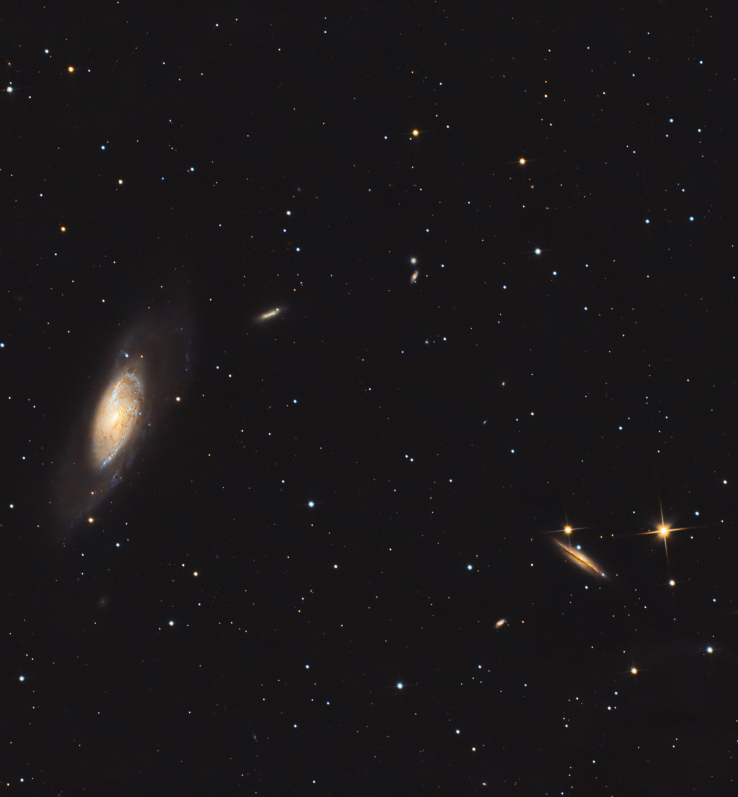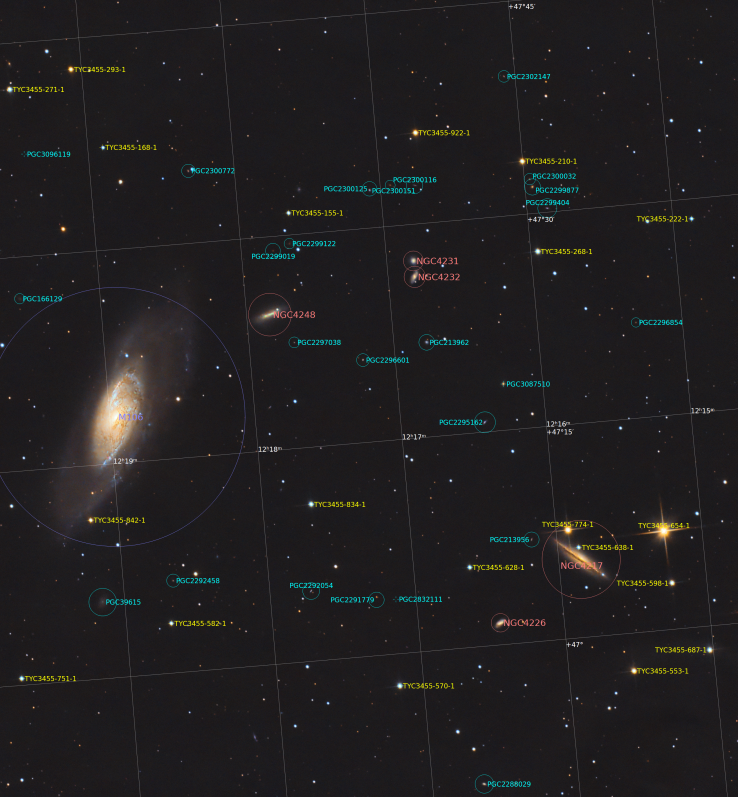M106 and NGC4248, NGC4231,NGC4232,NGC4217,NGC4226 from Bortle 9
Messier 106 (also known as NGC 4258) is an intermediate spiral galaxy in the constellation Canes Venatici. It was discovered by Pierre Méchain in 1781. M106 is at a distance of about 22 to 25 million light-years away from Earth. M106 contains an active nucleus classified as a Type 2 Seyfert, and the presence of a central supermassive black hole has been demonstrated from radio-wavelength observations of the rotation of a disk of molecular gas orbiting within the inner light-year around the black hole. NGC 4217 is a possible companion galaxy of Messier 106.
Two supernovae have been observed in M106: SN 1981K (type II, mag. 17),and SN 2014bc (type II, mag. 14.8).
M106 has a water vapor megamaser (the equivalent of a laser operating in microwave instead of visible light and on a galactic scale) that is seen by the 22-GHz line of ortho-H2O that evidences dense and warm molecular gas. Water masers are useful for observing nuclear accretion disks in active galaxies. The water masers in M106 enabled the first case of a direct measurement of the distance to a galaxy, thereby providing an independent anchor for the cosmic distance ladder. M106 has a slightly warped, thin, almost edge-on Keplerian disc which is on a subparsec scale. It surrounds a central area with mass 4×107 M☉.
It is one of the largest and brightest nearby galaxies, similar in size and luminosity to the Andromeda Galaxy. The supermassive black hole at the core has a mass of (3.9±0.1)×107 M☉.
M106 has also played an important role in calibrating the cosmic distance ladder. Before, Cepheid variables from other galaxies could not be used to measure distances since they cover ranges of metallicities different from the Milky Way's. M106 contains Cepheid variables similar to both the metallicities of the Milky Way and other galaxies' Cepheids. By measuring the distance of the Cepheids with metallicities similar to our galaxy, astronomers are able to recalibrate the other Cepheids with different metallicities, a key fundamental step in improving quantification of distances to other galaxies in the universe.
Astrometry.net job: 7481841
RA center: 12h17m12s.5
DEC center: +47°18′03″
Pixel scale: 1.186 arcsec/pixel
Orientation: 5.019 degrees
Field radius: 0.636 degrees
Resolution: 2623x2833
Locations: Home obs, Athens, Greece
Data source: Backyard
Locations: Home obs, Athens, Greece
Data source: Backyard
Imaging Telescopes Or Lenses : Sky-Watcher Explorer 130PDS
Imaging Cameras : ZWO ASI533MC
Mounts: Sky-Watcher NEQ6-Pro
Filters: ZWO UV IR CUT 1.25"
Accessories: DIY Motorized Focuser
Software: PixInsight · Nighttime Imaging 'N' Astronomy (N.I.N.A. / NINA)
Guiding Telescopes Or Lenses: Sky-Watcher 9x50 Finderscope
Guiding Cameras: QHYCCD QHY5
Acquisition details
Dates: March 22, 2023 · March 23, 2023 · March 24, 2023
Frames: ZWO UV IR CUT 1.25": 820×60″(13h 40′)
Integration: 13h 40′
Avg. Moon age: 1.92 days
Avg. Moon phase: 4.89%

